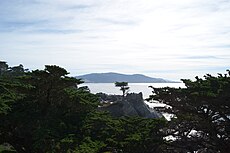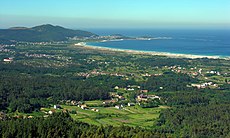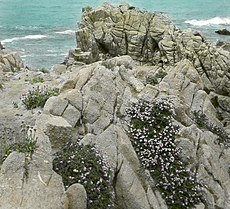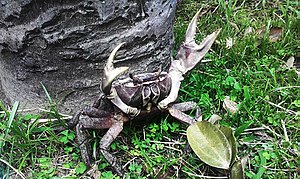Metrea
This page is currently undergoing major reconstruction in accordance with broader lore changes. |
Metrea is a state of the Kiravian Federacy located on the western coast of Great Kirav.
History
During the Archæic Era of Kiravian prehistory (roughly 8000 to 5700 BC), most of Metrea was inhabited by simple agricultural and horticultural tribes, presumed to have primarily been speakers of Gascanic languages directly ancestral to the modern Veuskan Coscivians and the Yutuxno urom tribe. Along the coast and perhaps in suitable sky islands of steam forest in the Coast Ranges, it can be inferred that there were communities that were socially stratified but at most semi-horticultural, with a traditional economy combining sedentary food collection, forest gardening, hunting, and fishing. Such communities may have spoken unclassified, unattested languages related to modern Varekthari, and perhaps also languages of Itaho-Atrassic stock.

Geography
Metrea borders the states of Ilfenóra to the north, Korlēdan to the east, and Argévia to the south, as well as the Atrassiv Ocean to the east. The Coastal Cascade Range of mountains lines the Atrassic coast, and its western slopes have a west coast marine climate that supports a lush temperate rainforest ecosystem, the southernmost spur of the great Kiravian Steam Forests. The Metrean segment of the Steam Forests is the most biodiverse area of Great Kirav and is home to a large number of endemic species, including the Mount Ridelvar giant salamander and the Kiravian White Cypress, the Federacy's official national tree which appears in the state's flag.
A fertile central valley, the climate of which borders on the mediterranean, spans the area between the Coastal Cascades and the Emynlúana Mountains in the western part of the state. This area is extremely fertile, and much of it is used for the commercial cultivation of spinach, bok choy, onions, leeks, scallions, turnips, cabbage, and various other vegetables.
While the largest individual city is Eparxa, at the southern end of the Coastal Cascades, the state's main population centre is the Mérosar metropolitan area, situated at the head of Metrea Bay and extending westward onto the adjacent peninsula as well as northeast into southern Ilfenóra.
 |
 |
 |
 |
 |
 |
 |
 |
 |
 |
 |
 |
 |
 |
 |
Society & Culture
General Demographics
Metrea has a population of over 27 million which, according to many statistical studies, constitutes one of the best-educated, most financially-stable, and most psychologically-healthy populations in the Federacy.
Although the largest individual settlement in Metrea is the southern city of Eparxa, the state's main population centre is the Mérosar metropolitan area, which radiates outward from its core city at the head of Méromonta Bay and spills westward onto the adjoining Tergisur Peninsula and northward into southern Ilfenóra State.
Languages

The West Coast Marine Coscivian dialects, when counted as a single language, constitute the largest language in Metrea by number of native speakers. The four dialects native to Metrea - Esselenic, Isuosaronic, Kapaśian, and Kontrakosan - are the main languages of daily life and interethnic communication in the coastal and coastal montane parts of the state, and a literary standard based primarily on the Esselenic dialect spoken in and around Mérosar serves as one of the government's working languages. This official register is somewhat different from the standard written forms used in Ilfenóra, Kaskada, Venèra, and Lataskia, but is the same as the standard written form used in Argévia. Localist activists from areas speaking the other dialects (especially Kontrakosan, which has more native speakers than Esselenic but is spoken far away from the capital) have long agitated for greater recognition of written forms based on their own speech patterns.
The other two largest languages in Metrea are Serradan Coscivian and Kiravic Coscivian. Both languages have official status on par with West Coast Marine Coscivian. Serradan Coscivian is the main language of everyday life in the central valley, especially in rural areas, though Serradan-speaking communities can be found in most cities and large towns outside of traditionally Serradan-speaking regions. Kiravic is spoken as a native language by a large minority of people in and suburban urban areas, as well as in a few smaller towns established during the Silver Rush by migrants from Central, Northern, and Eastern Kirav. As the federal official and de facto national language, Kiravic is widely understood and nearly all educated Metreans can functionally communicate in the language. The state's Urom languages, including Yutuxno and the isolate Varekthari, are recognised and receive some developmental support from the state government. Varekthari is of significant interest to the disciplines of language preservation/revitalisation and indigenous rights for its speaker community's remarkable success at maintaining relatively high rates of language use and intergenerational transmission despite most speakers living within the predominantly Coscivian Mérosar metropolitan area.
A large number of ethnic vernacular languages such as Paisonic Coscivian dialects, Lusan Coscivian, Kastrovan Coscivian, Paulastran, Æonaran and Umcaran Coscivian, Cape Coscivian, Eskean Coscivian, Melotic, Qihuxian, Antaric Coscivian, and Kuatan Coscivian are spoken among their respective communities, mostly as a home and neighbourhood language. It has been observed that over the last two generations speakers of the several related Iatid languages common in the state have formed a pidgin or creole often called Panneròn.
Ethnosocial Groups
As several areas of Metrea are well-suited to the cultivation of hops, there are five Coscivian hop clans historically based in the state. The hopper population of the state has been augmented in modern times by individual hopper families moving to Metrea from other states.
Religion
Catholicism, primarily practiced according to the Coscivian Rite, is the majority religion in Metrea, with around 80% of the population adhering to the Catholic Church. Rural and micropolitan communities in the state's inland areas form part of the Farravonian Rosary Belt, a continuous chain of similar communities stretching from northern Argévia to Inokarya where Catholic devotions are an especially important fixture of daily life. Coscivian Orthodoxy, Ruricanism, Marcevangelista Catholicism, and Iduanism are the next largest religions by number of followers.
Cultural Life
Metrea is described as having a laid-back but sophisticated culture and a strong middle class ethos.
Metrea is a prominent centre of Kiravian cultural life,
Very cultured, music festival, cultural establishments, notable artists and writers
Major destination for cuisine
Golf and sports - The Mérosar Rays of the Federal Fieldball League play at [Prominent Firm] Stadium in Kelanova.
Government

Metrea is a semi-presidential republic as laid out in its constitution, with a tripartite-trifunctional legislative and fiscal process involving three institutions: the Congress of Metrea, the College of Auditors, and the State Council or Executive College.
There is a vital tradition of direct democracy in Metrea, especially on the local level. Like many Western Kiravian states, Metrea makes extensive use of ballot initiatives and referenda, and allows its Chief Executive to be recalled. Many municipal charters in the state require that legislation pertaining to budgets, land use, and public utilities be approved by popular vote.
Party-Political Landscape
["Many Parties, Two Systems" arrangement; Proporz]
Local Government
There are three types of local governments in Metrea: Sar (translated as both "city" and "town"), kosuv ("village"), and xlagūtakta ("tribal governance area"). Cities are governed by annually elected five-member commissions (except for Mérosar and Eparxa, which have seven-member commissions) and (with the exception of Mérosar) administered by a Steward appointed by the commission. Villages are governed by... The human geography of Metrea necessitates both strong municipal governments to care for densely clustered urban populations and strong county governments to deliver services among scattered municipalities and govern large areas of unincorporated land.
Federal Politics
| Member | Party | First Elected | |
|---|---|---|---|
| Ibudan Castoridran | Caritist Republican (CSU) | 21185 | |
| Antonin Valera | Shaftonist Civic Party (FRA) | 21192 | |
| Èuseviur Faramínen | Shaftonist Civic Party (FRA) | 21197 | |
Law
The law of Metrea subsists in its constitution, statutes, and corpus of Cultivated Law.
Metrea is a fusional marriage state, wherein a married couple is treated as a unitary person for most purposes of civil law. First-cousin marriage is banned. The maximum allowable age difference between spouses under 30 is three years.
Capital punishment was abolished in Metrea under the restored and updated state constitution adopted after Kirosocialism.
Metrea has a seatbelt law that is not actively enforced. It requires vehicle registration plates on the aft end of four-wheeled motor vehicles only.
As in most Kiravian provinces, Metrean judiciary has a three-tiered structure. A trial court serves each of the state's countyships, and rulings handed down by these courts may be appealed to one of the four regional Courts of Revision. The Mérosar High Court (which has an auxilliary bench in Eparxa) is the state constitutional court and highest court of appeal. A Court of Public Adjudication sitting in Kelanova was established in 21198 to hear constitutional cases, certain cases involving public bodies, and cases with countyships and municipalities belonging to different countyships as parties.
Economy
Metrea's economy is rated among the High-Income Provincial Economies by the federal Executive for Development and Regional Balance. It has a promising long-term growth prospectus, high GRP per capita, a high integral development index and living standards, and a favourable fiscal and regulatory regime. Key industries include information technology, biotechnology (chiefly agricultural), healthcare, education, beer and wine, agriculture, fishing, and tourism.
Algaculture
Metrea is a major producer of algæ and algal products, such as carageenan, agar, etc.
Economy
Metrea's economy is rated among the High-Income Provincial Economies by the federal Executive for Development and Regional Balance. It has a promising long-term growth prospectus, high GRP per capita, a high integral development index and living standards, and a favourable fiscal and regulatory regime. Key industries include information technology, biotechnology (chiefly agricultural), healthcare, education, beer and wine, agriculture, fishing, and tourism.